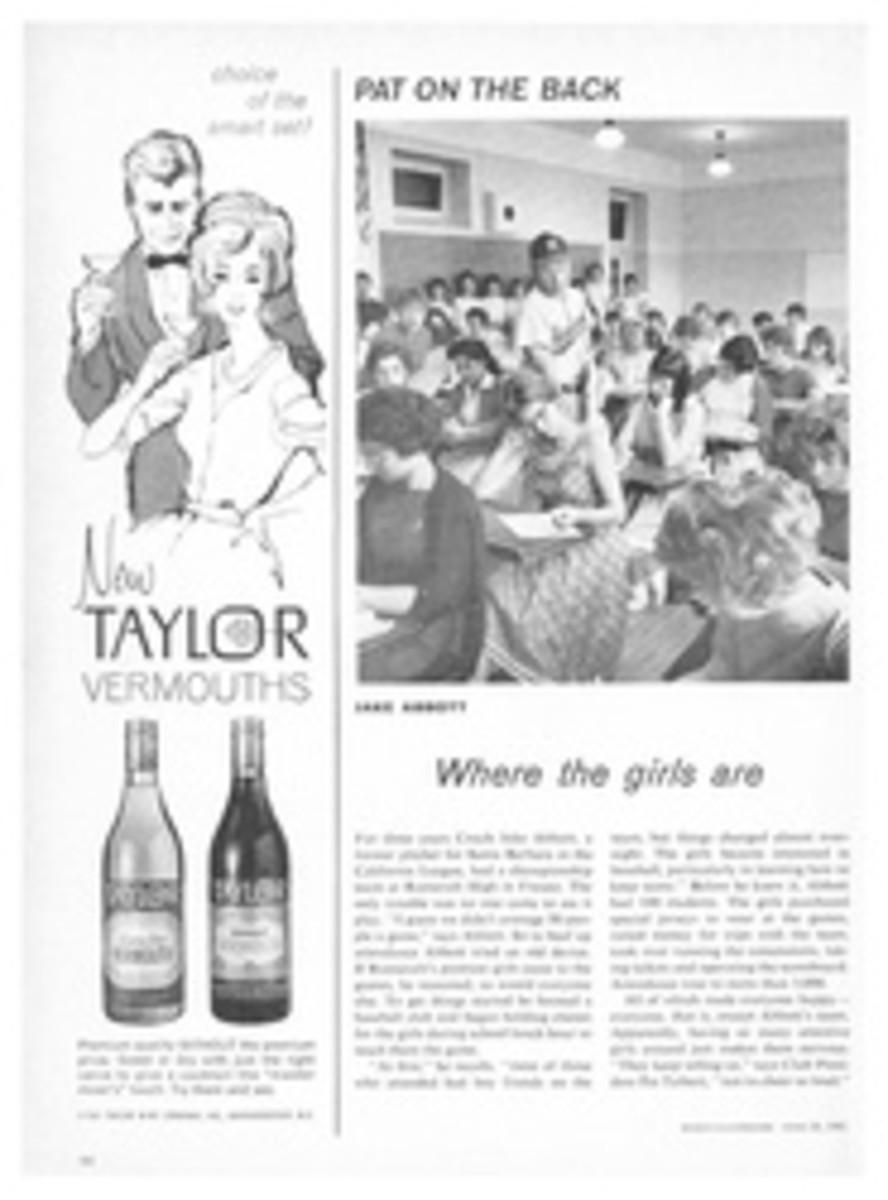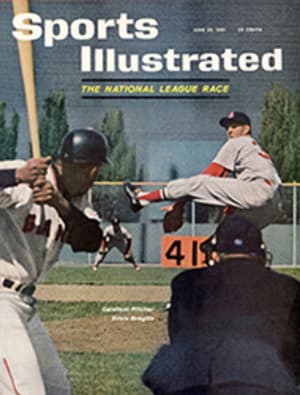
The NCAA visits the wild East
In selecting a site for its annual track and field championships, the National Collegiate Athletic Association has always shunned Eastern Daylight Time as though it were computed on a slow stop watch. The best place to hold a track meet, as almost anyone knows, is in the West, and the farther west the better.
But last weekend, for the first time in the NCAA's 39-year history, the college boys were finally lured east to spend two days running and jumping and throwing things around Franklin Field, which is part of the University of Pennsylvania, which is in Philadelphia—West Philadelphia. By the time they had completed their chores, some amazing results were noted. It didn't snow once. The ivy on the neighboring walls proved to be of a nontoxic variety. All gangs dealing in stolen shotputs had been run out of town, presumably along with Blinky Palermo, and not one California coach was found floating, stop watch stopped, in the Delaware River.
As a matter of fact, it was rather a good meet. There were a number of brilliant races, seven records were set, and the University of Southern California departed with its 21st team championship, right on schedule.
There were complaints, of course, about the old cinder track at Franklin Field, which was first laid down in 1895 and has hardly been disturbed since, except to drag a few spike-scarred bodies away each spring after the Penn Relays. A number of people ran over it very well, however. Dyrol Burleson of Oregon, warming up for his duel with Jim Beatty in the National AAU mile at Randalls Island in New York this weekend, idled along for three laps, then scampered off to disappear from the rest of the field and win in 4:00.5. By running the last quarter mile in 54.7 seconds, the deeply bronzed boy with the strange, scuttling stride broke Ron Delany's NCAA record of 4:03.5 without half trying.
"I really didn't intend to run that fast," said Burleson, who is so much better than other collegians that he is almost ashamed to run against them. "I was trying to keep the pace slow, so our other two milers, Keith Forman and George Larson, would have a better chance." But even though his tactics were successful—Forman finished third behind Bill Dotson of Kansas, and Larson finished sixth—Burleson was a bit disappointed once he heard the time.
"If I had known I was going to come that close," he said, "I'd have run a four-minute mile for these nice people here." Since Burleson has already run three sub-four-minute miles, including the world's best time for 1961 of 3:57.6, this was not entirely conceit. He plans to run 3:56 this summer and 3:54 before another year is out, which would break Herb Elliott's world record and provide as adequate and dignified an answer to the Cambridge philosopher (see page 36) as any American could hope to give.
Two for Frank Budd
Another who ran well was Frank Budd of Villanova, the meet's only double winner. This has been a subpar year for sprinters born in the U.S., but there is nothing subpar about Budd. As a small boy in Asbury Park, N.J., Budd was a polio victim, and he reached college with a right knee and calf considerably less sturdy than his left. To build up Budd's right leg, Jumbo Elliott of Villanova put the youngster on a heavy schedule of exercises, one of which consisted of running up and down the stadium seats. On Saturday, Budd appeared ready to run up the stadium seats and right out of the park. He won the 220 around a turn by three yards over his good Villanova teammate, Paul Drayton, in 20.8 seconds; he won the 100 by more than a yard from Harry Jerome of Oregon in 9.4.
Budd has equaled the world record of 9.3 for the 100 twice this year, and he was happy to win so easily over Jerome, who is from Canada, and who has also run 9.3. His only disappointment was the absence of Dennis Johnson, San Jose State's injured Jamaican sprinter who has done 9.3 four times this year. "I was hoping to get this thing settled," said Budd.
Pat Clohessy, an Australian who is part of the University of Houston's foreign legion, set a three-mile record of 13:47.7, and John Lawler, another Australian who somehow found himself one day attending classes at Abilene Christian College, set a 3,000-meter steeplechase record of 9:01.1. In the absence of Southern California's injured Rex Cawley, Occidental's Dixon Farmer raced off with the 440-yard hurdles in 50.8. Since this is a new NCAA distance for the intermediate hurdles, Farmer's fine performance stands as a record, too.
The two best races of the meet neither threatened any records nor resembled each other in the slightest. One was close, the other a completely unexpected runaway. The first was the 440-yard dash, and the reason Adolph Plummer of New Mexico failed to break a record is that the NCAA mark for the quarter mile is also the best ever run in the world, Glenn Davis' 45.7 in 1958. But Plummer, a big powerful 23-year-old Air Force veteran from Brooklyn who went to New Mexico after learning to run in North Africa, turned in the best time of his life, 46.2 seconds, and defeated one of the meet's big favorites, Abilene Christian's Earl Young.
"I knew Young was the one I had to beat," said Plummer. "I watched him in the preliminaries on Friday, and then I ran against him in the first semifinal heat. So I knew about what to expect. I figured the race would be won on the last curve, and I decided to run it harder than he did.
"It's funny," he went on. "It didn't work out like that at all. They say the good Lord watches over fools and little babies, and I'm sure no baby."
First 220 too slow
Plummer won the race because Young ran his first 220 too slowly. Young misjudged the pace—he was three lanes inside of Plummer on the strangely staggered track—and when he suddenly realized what was happening it was too late to do anything about it, though he tried. He blazed into the curve, passing the weaker runners as though they were standing still, and passing the strong ones, too. He went by Norm Monroe of Oregon State, who was to finish fourth; he went by Walter Johnson of North Carolina College, who had run 46.3 just a few weeks earlier, who was to finish third; then, at the top of the stretch, he caught Plummer—and inched ahead. But the effort had been too great; 20 yards from the finish Young began to wobble, and Plummer, driving desperately, caught him at the tape. A picture from the Bulova Phototimer was needed, to determine the winner.
Both Plummer and Young were timed in 46.2. Johnson and Monroe ran 46.4, Jimmy Wedderburn of NYU ran 46.8, and Jim Baker of Missouri ran 46.9 in sixth place. It was one of the most exciting quarter-mile races ever seen. "I just got beat," said Young. "He ran a better race, and I got beat. Maybe next Saturday...."
Next Saturday John Bork of Western Michigan will be 22 years old. Last Saturday he won the NCAA 880 in 1:48.3, which is one of the better times in the world this year. It is strange that Bork should win the 880 because he had never really considered that his race. "Two years ago," said the young man from Detroit, "I was a quarter-miler. Last year I figured my best chance would be in the 400-meter hurdles, but I never could get the rhythm somehow. This year I just started running the half mile."
He ran 1:49 two weeks before the collegiate meet and suddenly found himself a co-favorite along with Michigan's Lithuanian-born Ergas Leps. It was to be a tactical race, and everyone knew the tactics: Bork, a front runner, would go out with Drake's Charles Durant and try to hold on; Leps, a great finisher, would come from behind. Naturally. Except that Leps went out early and Bork found himself at the tail end of the parade, trapped and pocketed and going nowhere. In fury at his own clumsy race, Bork burst out of the pack on the backstretch of the second lap, pounded up even with Durant and Leps—and kept right on going. He led by five yards into the curve, he led by 10 yards coming out of the curve, by 15 yards in the straightaway, and by almost 20 yards at the tape.
Not all of the big performances or records were restricted to running events. Dallas Long of USC, the huge, blond lump of muscle who held the old collegiate shotput record of 61 feet 9 inches, broke that easily with a 63-foot, 3½-inch heave. His teammate, Luther Hayes, raised his own hop, step and jump record to 51 feet 2¼ inches. John Thomas cleared seven feet in the high jump, found himself tied with Southern Cal's Bob Avant, and jumped again, at 7 feet 2. He left the bar bouncing gently on the standards—but still up there—for another record. It was the first time in a collegiate meet that two men had gone seven feet.
It was also the first time in a college meet, or anywhere else, that eight pole vaulters did 15 feet. Three of them—George Davies of Oklahoma State, the new world-record holder at 15 feet 10¼ inches, Dick Gear of San Jose State and Jim Brewer of Southern Cal—then went to 15 feet 4 inches and a three-way tie for first.
As the meet came to an end, a University of Pennsylvania official, thinking of the new records and the fine races that had been run on old Franklin Field, smiled. "The facilities," he said with some pride, "couldn't have been too bad."
"I would be more inclined," replied a California coach, "to attribute the results to some pretty good boys running around down there. No telling what they might have done out West."
The East may not get another NCAA track and field championship for 39 more years.
PHOTO
FIBER-GLASS POLE bends like a bow as the world record holder, George Davies, springs toward a tie for the NCAA title.

